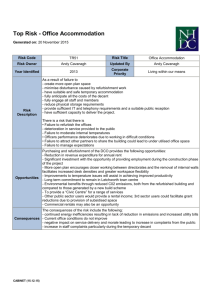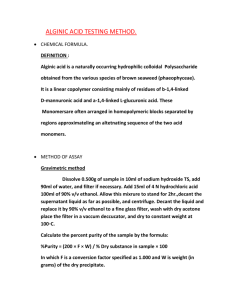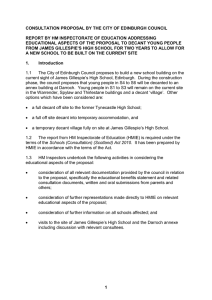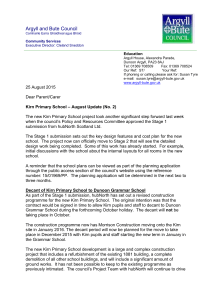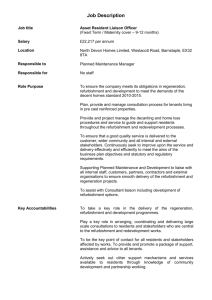Consultation proposal by The City of Edinburgh Council
advertisement
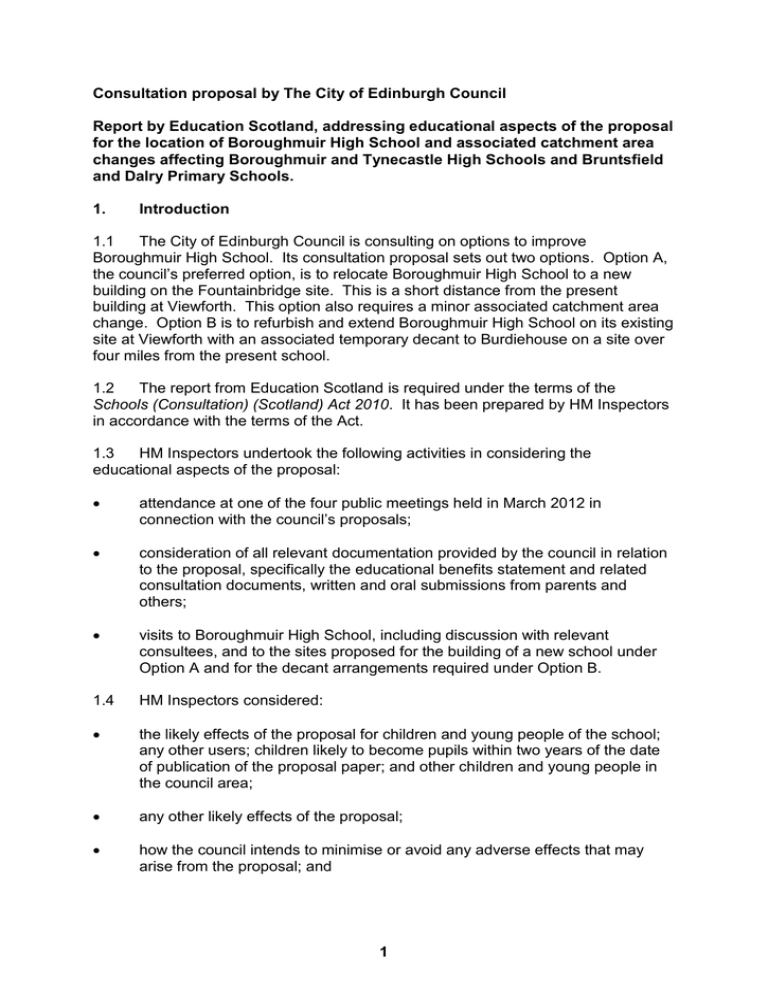
Consultation proposal by The City of Edinburgh Council Report by Education Scotland, addressing educational aspects of the proposal for the location of Boroughmuir High School and associated catchment area changes affecting Boroughmuir and Tynecastle High Schools and Bruntsfield and Dalry Primary Schools. 1. Introduction 1.1 The City of Edinburgh Council is consulting on options to improve Boroughmuir High School. Its consultation proposal sets out two options. Option A, the council’s preferred option, is to relocate Boroughmuir High School to a new building on the Fountainbridge site. This is a short distance from the present building at Viewforth. This option also requires a minor associated catchment area change. Option B is to refurbish and extend Boroughmuir High School on its existing site at Viewforth with an associated temporary decant to Burdiehouse on a site over four miles from the present school. 1.2 The report from Education Scotland is required under the terms of the Schools (Consultation) (Scotland) Act 2010. It has been prepared by HM Inspectors in accordance with the terms of the Act. 1.3 HM Inspectors undertook the following activities in considering the educational aspects of the proposal: attendance at one of the four public meetings held in March 2012 in connection with the council’s proposals; consideration of all relevant documentation provided by the council in relation to the proposal, specifically the educational benefits statement and related consultation documents, written and oral submissions from parents and others; visits to Boroughmuir High School, including discussion with relevant consultees, and to the sites proposed for the building of a new school under Option A and for the decant arrangements required under Option B. 1.4 HM Inspectors considered: the likely effects of the proposal for children and young people of the school; any other users; children likely to become pupils within two years of the date of publication of the proposal paper; and other children and young people in the council area; any other likely effects of the proposal; how the council intends to minimise or avoid any adverse effects that may arise from the proposal; and 1 benefits which the council believes will result from implementation of the proposal, and the council’s reasons for coming to these beliefs. 2. Consultation process 2.1 The City of Edinburgh Council undertook the initial consultation on its proposals with reference to the Schools (Consultation) (Scotland) Act 2010. The consultation included an invitation for written submissions. There were four public consultation events, which gave parents and other members of the public the opportunity to hear presentations from and ask questions of council officials and senior members of Boroughmuir staff. The consultation events included presentations showing the location and configuration of the new school at the Fountainbridge site under Option A, and the site proposed for the decant under Option B. 2.2 The council received written responses from 177 groups and individuals to the consultation. Of those expressing a preference, almost 90% were in favour of Option A, the new build at Fountainbridge. However almost half of those who favoured this option expressed varying degrees of concern in relation to aspects of the proposed provision. These concerns mainly related to the constraints of space in the proposed Fountainbridge site, especially for sport, and to the positioning of the proposed public park at Fountainbridge relative to the planned school buildings. 2.3 Just over 10% of those written consultation responses expressing a preference favoured the refurbishment Option B. There were a variety of reasons given for this preference including a view that this option had better long term sustainability than Option A, preserved better the tradition of education in the Viewforth area and that an imaginative refurbishment would produce an exciting educational environment. Some of those favouring Option B, also had concerns in relation to safe walking routes to the Fountainbridge area from the bus stops used by young people and in relation to the physical environment in the area around Fountainbridge. 2.4 Consultation responses demonstrated a high degree of concern over the decant proposal within the refurbishment Option B proposal. Altogether, of the 177 written responses, just under half included expressions of concern about the proposed decant to Burdiehouse. This number included around 60% of those who favoured Option A but also over half of those favouring Option B. The Burdiehouse decant was generally regarded as highly disruptive to children’s education as well as being very problematic in terms of travel arrangements. The most common alternative suggested to the Burdiehouse decant was instead to decant to the Fountainbridge site (the proposed location for the new build in Option A). 2.5 Around 15% of the 177 written responses expressed no clear preference for either of the council’s two Options. A significant proportion of these, as well as some of those favouring both Option A and Option B, expressed to varying degrees the opinion that the choice of Burdiehouse as the decant site for the refurbishment proposal (Option B), had resulted in the consultation being skewed in favour of the new build at Fountainbridge (Option A). A few of those who stated an overall preference for Option A made it clear that, had there been an alternative 2 arrangement proposed for the decant, they might have favoured instead the refurbishment option. However other parents explicitly stated that they would not have been in favour of a decant regardless of the location of the site. 2.6 The council had not taken a systematic approach to gathering the views of children and young people on its proposal. However, the main aspects of the two options had been shared with the Boroughmuir pupil council earlier this session. This representative group, after initially favouring a refurbishment of the existing building, changed its preference overwhelmingly to the new build at Fountainbridge option, after taking into account the implications of the Burdiehouse decant. A group of S1–S3 pupil council members interviewed by HM Inspectors were very strongly of the view that a decant to Burdiehouse was not in their best interests. They felt that it would be better to have continuity of education in the present building followed by a smooth transition to a new build school at Fountainbridge. 2.7 As part of the process leading to the council’s specification for the new school, teaching staff were consulted on a subject department basis on the type of accommodation they would wish to have to enable them to deliver a modern education. They are to be consulted again at a more detailed level on specific points in the planning for the refurbished or new building following a decision on which option is to proceed. HM Inspectors met with a representative group of teaching staff. This group were all in favour of Option A and felt that other teachers from their departments would take the same view. They felt that the Burdiehouse decant would pose significant problems in terms of its location, travel arrangements, facilities on site and the resulting delay in the move to a modern teaching environment. They also felt that some parents might move their children to another city school rather than have them educated in a temporary site in an inconvenient location. At the same time this group had some concern about the lack of space for outdoor education and sport at Fountainbridge and hoped that a way might be found of allocating more space for the dedicated use of the school. A small group of administrative and support staff interviewed had mixed views but most favoured the refurbishment option for a variety of reasons. 2.8 The headteacher and the senior management team strongly supported the new build at Fountainbridge, Option A. The school’s Parent Council provided a written report to the council which also indicated very strong parental support for the new build at Fountainbridge. However, the Chair of the Parent Council confirmed that parents had important reservations in relation to the limitations of space at Fountainbridge, the lack of outdoor sports provision and the location of the park in relation to the school. Many parents felt that the council should now make every effort to find additional space dedicated to school use from the area of land now owned by the council at Fountainbridge. They felt it should be possible to find space to provide the school with additional dedicated outdoor sporting facilities without unduly restricting the ability of the council to use the remaining space in a way appropriate to wider regeneration development. The Merchiston Community Council submission also supported Option A. However, the Morningside Community Council submission expressed concerns about limitations of space and the location of the new build site in relation to Option A. It favoured refurbishment but also requested that the council consider alternatives to the Burdiehouse decant. 3 3. Educational aspects of the proposal 3.1 There is general agreement that the present quality of the school’s accommodation is no longer suitable for 21st Century education. In 2004 the council placed the school as the top priority for replacement in its second schools Public Private Partnership project. This followed an HM Inspectorate of Education (HMIE) inspection in 2001 which evaluated the school’s accommodation as having important weaknesses and recommended that the school’s accommodation should be improved as resources allowed. The council however experienced great difficulty in finding a suitable and affordable site for a new building. Another HMIE inspection in 2008 recommended that the school and education authority should ‘actively address the inadequate accommodation and facilities’. The school had in fact already been included in the council’s Wave 3 school replacement programme. Following a Government offer of funding in 2010 towards the cost of the construction of a new school, the council purchased the Fountainbridge site in order to enable the option of a new school to be built. 3.2 In 2011 the council employed an experienced education design advisor to lead a project to develop a Strategic Educational Design Brief (SEDB) for the new school. This development involved consulting school staff so that their vision for learning and teaching and how this might be organised within a new building could be taken fully into account. The resulting SEDB specifies the accommodation requirements to enable young people to experience a quality education fully in line with Curriculum for Excellence. It incorporates an approach to organising and locating subject departments within five faculty zones with a layout which supports interdisciplinary work with larger groups of learners as well as class and individual/smaller group learning. The SEDB would provide significantly enhanced facilities for learners and staff. As such, a school built to the SEDB specification would provide the facilities suitable for a modern education and enable the school to meet fully its aspirations in relation to Curriculum for Excellence. A new build at Fountainbridge would provide a building fully meeting the SEDB specification. However, the council has indicated that, if Option B were pursued, the constraints of the old Viewforth building mean that there would inevitably be compromises in the layout giving a reasonably good but not perfect fit with the SEDB specification. Nevertheless, either of the council’s two proposals, Options A or B, would provide learners with a considerably enhanced learning environment over and above the present provision. 3.3 The council recognises that neither of the two options being proposed will result in a school fully meeting the requirements of the Schools Premises Act 1967 with regard to the size of the site. Under either option the council is planning for a school roll of 1150 which it considers sufficient for projected future school intake. The Fountainbridge Option A site would provide 1.0 hectares with access to a proposed 0.3 hectare public park which the council considers the school could utilise for both recreational and learning opportunities. The council has made a submission to Scottish Ministers requesting dispensation for a new build at Fountainbridge under the 1967 site size regulations. The Option B refurbishment proposal would be undertaken within the present and smaller Viewforth site. The overall floor space in the building within the SEDB specification for either option meets or exceeds the requirement of the 1967 Act. 4 3.4 The facilities proposed under Option A at Fountainbridge represent a significant improvement on the present accommodation. The total area of space for educational use would be significantly greater than at the present Viewforth site without the need for young people to travel to another building for parts of their education. This is presently the case at Viewforth where young people have to cross a road and walk along a public street to reach the building used for aspects of expressive arts provision. The positioning of the park, which is integral to the planning permission already granted for halls of residence for Napier University students at Fountainbridge, was a matter of concern for some parents who would prefer this space to be given to the school for additional sport facilities. The council is presently investigating the possibility of making some alteration to the park configuration. However, even with no change to the present plan, there would undoubtedly be advantage to the school in having a small park area in close proximity to the school to be used at times for educational purposes and for young people to use at lunch times. For the latter purpose the park area would provide a suitable area without any need for young people to cross streets. 3.5 At present the school makes use of outdoor playing fields at Meggetland some 1.4 miles from the Viewforth site, an arrangement which has been criticised in the past by HM Inspectors. Both of Options A and B require a continued need to make use of Meggetland, which is also 1.4 miles from the Fountainbridge site. Although the sporting and changing facilities at Meggetland have been upgraded significantly, the need to bus pupils to and from the school remains a weakness in the school’s provision and is costly both in terms of time and money. The importance of improving young people’s heath and fitness is now a Scottish Government priority. These factors strengthens the argument, supported by a high proportion of those responding to the consultation, that the council should do everything in its power to maximise facilities for sport and outdoor activity at the Fountainbridge site. The council intends that under Option A, the new building at Fountainbridge would have a multi-use games area or outdoor pitch through innovative use of roof decks. It has confirmed the feasibility of this through investigating similar approaches in some London schools. Staff in the school feel it may be possible as part of option A to develop an area which could be used for sport and exercise both by the school and by members of the community at evenings and weekend. Limitations of space and probable planning constraints at Viewforth prevent any comparable additional sports facilities within Option B. Although the roof deck proposal within Option A is a welcome strengthening of the school’s sporting facility, the council should continue to explore all options within the Fountainbridge site to provide additional space for sport and outdoor activity. 3.6 The important weaknesses identified in the accommodation at the present Viewforth site continues to place limitations on the quality of young people’s educational experiences. In particular, the layout of the accommodation restricts the extent to which teachers are able to employ imaginative and stimulating approaches in line with Curriculum for Excellence. It is therefore desirable that the new school is built as soon as possible. The council’s proposal paper outlines a timescale for each option. It is envisaged that the new build at Fountainbridge Option A would start on site in the summer of 2014 with a completion in summer 2016 ready for the 2016/17 school session. As a result, the current S1 cohort would benefit from the new school when in S6. For the refurbishment Option B, the council expects that it would be late 5 2014 before work could start on-site and that the refurbished building would not be completed until early 2018. As a result, none of the present Boroughmuir High School pupils would benefit from the new building. Those currently in P7 would move into the refurbished building towards the end of their S6 year. 3.7 Under Option B, there would be a need to decant the whole school to alternative premises for the three year duration of the refurbishment. There is reasonable and widespread parental and teaching staff concern about the impact of this on young people’s educational experiences. After considering a large number of potential decant sites, the site of the former Burdiehouse Primary School was selected as the location for the construction of a school decant village. This would consist of temporary accommodation including two-storey modular units with a 700 square metre temporary gym hall for sports and assembly. There would be some play space. The council recognises that the location of the site, well outside the catchment area and some 4.3 miles from the present school building is problematic. The area is well served by a bus route connecting it to the Boroughmuir catchment area. However, because of the distance involved over 500 young people would require bus passes for the duration of the decant. At the moment, fewer than 30 require bus passes. Those directly affected under the planned timescale would include young people presently in P2 through to those currently in S3. The most significant impact would be on seven cohorts of pupils from the present P3 to the present S2 who would all be decanted for more than one session. 3.8 At present, Boroughmuir is one of the most utilised schools in the city for adult evening education. Option A would allow these classes to continue at Viewforth and then move to the new school at Fountainbridge without disruption. Under Option B, the situation is less clear as for a three year period accommodation for the evening classes would have to be found elsewhere in the city. The situation under Option B is further complicated by the fact that at the nearby James Gillespie’s High School, major construction work and a partial decant would, for at least a year, overlap with the closure of the Viewforth building for the Boroughmuir refurbishment. In consequence the space available in the local area for adult education would be significantly reduced. Alternative provision in other areas of the city may not be attractive or convenient for many adult users. 3.9 The new building at Fountainbridge under Option A would be marginally outside the present catchment area so that this option includes a proposal to extend the Boroughmuir catchment area to the north. This is a relatively minor change which affects only two residential streets with a very small number of school aged children. 3.10 In the case of both options there are factors to be considered in relation to the routes taken by young people to school. In the case of Option A, the proposed Fountainbridge site is some 430m north of the existing site. This means that many young people getting off the bus at Bruntsfield Place would have further to walk to school. The council is aware of the importance, if this option is chosen, of ensuring that any necessary changes to traffic and canal crossing arrangements are made to ensure the safest possible route to school and has begun to investigate the possibility of a new pedestrian bridge to the planned school site. In the case of Option B, the council would have to consider how best to ensure young people’s 6 safety given the likelihood of increased traffic in the area. In addition, there would have to be careful consideration of whether existing bus capacity would be sufficient for the additional volume of young people likely to be travelling to and from one part of the city to another. 4. Summary 4.1 The present Boroughmuir High School building is no longer fit for purpose and there is general agreement that a new school should be built or the present building refurbished. The council has developed a specification for a new school. A building meeting this specification would provide learners and staff with very good facilities for meeting the requirements of a modern 21st century education. Young people would benefit from significantly improved social and educational facilities in a building with well-resourced accommodation designed to promote flexible learning and teaching approaches consistent with Curriculum for Excellence. 4.2 Either of the council’s proposals would result in a school campus of limited size and with a continued need to make use of playing fields some 1.4 miles from the school building. However, given that these arrangements for sport are a continuation of the present situation, and that either option would meet the council’s SEDB specification, there is no doubt that those young people attending such a school would have a clear educational gain as compared to their being taught in the present building. 4.3 Despite the limitations of space and the continued need for young people to make use of Meggetland for part of their physical education programme, HM Inspectors are of the view that the new build option at Fountainbridge, Option A, is to the overall educational advantage of the young people concerned. A building meeting the council’s SEDB specification has the potential to enable staff to deliver a high quality educational experience. The new build option also has the great merit of not requiring any decant thus avoiding any disruption to young people’s education as the school can continue to make use of its present accommodation at Viewforth until the new building is ready. This option also allows community users to continue to benefit from the use of a local school. If this option is chosen it will be important for the council, while taking into consideration the needs of the wider community and the need for regeneration of the local area, to seek to maximise the amount of space at the Fountainbridge site for outdoor activity. In taking forward its proposal, the council needs to also give careful consideration to any potential traffic risks to young people and take appropriate steps to minimise these. 4.4 In the case of the refurbishment Option B, despite an eventual educational gain in relation to the present accommodation, there is the potential negative impact of the proposed three year decant to the Burdiehouse site to consider. The overall impact of a decant over such a long period on young people’s education is not easy to predict. However, there are several adverse factors associated with the decant which cumulatively raise concerns about the overall impact of this option. These relate to a number of factors. These include the inevitably restricted educational experience in a decant site of the kind proposed, the very limited social facilities for young people and the logistical and travel issues involved in large numbers of young people having to travel over four miles to Burdiehouse. Option B also delays further 7 the benefit to young people of a move to a learning environment suitable for 21 st century education, as this would not take place until 2018, while under Option A the move would take place in 2016. The educational benefits of Option A clearly outweigh the benefits of Option B. HM Inspectors Education Scotland May 2012 8
